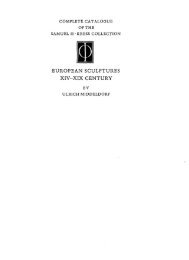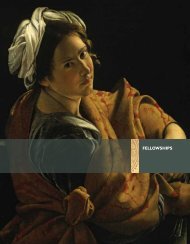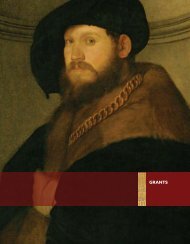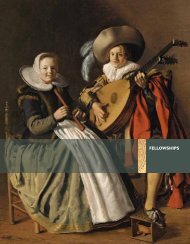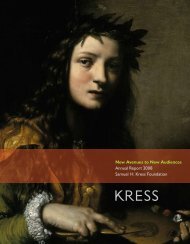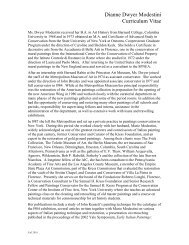The Campus Art Museum - Samuel H. Kress Foundation
The Campus Art Museum - Samuel H. Kress Foundation
The Campus Art Museum - Samuel H. Kress Foundation
Create successful ePaper yourself
Turn your PDF publications into a flip-book with our unique Google optimized e-Paper software.
1969, enabling government support for public institutions that were educational,<br />
provided further incentive for museums to embrace outreach to public schools. <strong>The</strong><br />
economic downturn of the 1980s contributed to an even greater focus on education.<br />
<strong>Museum</strong>s turned “from adding to their collections to increasing educational<br />
services and programs for the public” (Williams 2007, 59).<br />
<strong>The</strong> change from a collections-driven to an education-centered museum<br />
has had significant consequences for how museums represent themselves. “<strong>The</strong><br />
collection holdings are no longer viewed as the primary measure of value for a<br />
museum; rather, the relevant and effective role of the museum in service to the<br />
public has become the core measuring stick” (Anderson 2004, 4). Nonetheless, even<br />
in the first decade of the twenty-first century this educational outreach was more<br />
to the community and its schools than to students in non-art disciplines at the<br />
college or university (Bradley 2009). Signs indicate, however, that the art museum<br />
is once again becoming a site of teaching and research on college and university<br />
campuses, but this time, not for art departments alone. “<strong>Campus</strong> museums may<br />
become privileged places for pedagogical innovation,” states Bradley (2009, 2). She<br />
continues, “success requires flexibility and resources” (2009, 2). This report seeks<br />
to address ways in which these pedagogical innovations are taking place, with and<br />
without extra funding.<br />
At Oberlin College, a literature professor reflected on his use of the Allen<br />
Memorial <strong>Art</strong> <strong>Museum</strong> (AMAM) as a classroom:<br />
<strong>The</strong> museum as a classroom is a wonderful resource for dialogue and finding<br />
multiple points of view…. I just love the museum as a place where you bust up<br />
the formality and the stodginess of the classroom…. I use it for my Shakespeare<br />
classes now.<br />
An art history professor there described the museum as “an integral part of the curriculum:”<br />
I think what is happening now is that people are using the museum in ways<br />
that have become so deeply entwined into the curriculum and not just<br />
humanities but also social sciences and sciences… that it’s just becoming an<br />
integral part of the curriculum – for a physics person to talk about light, color,<br />
and vision using an impressionist painting; for an historian to come over and<br />
analyze the psychology of how you present art in the museum and the politics<br />
of collecting and politics of label writing. Frankly, right now we could use a<br />
couple more [academic curators] and a couple more rooms to study things in.<br />
You can’t turn the faucet off now.<br />
Although the above quotations are in reference to the AMAM, similar<br />
testimonies describe other campuses where focused attention and effort is directed<br />
at integrating the art museum into the academic life of the campus. <strong>The</strong> AMAM<br />
works with nearly every department at Oberlin, around thirty-nine departments.<br />
<strong>The</strong>y had 142 class visits from nineteen different departments during the 2010-11<br />
academic year, and the museum was not even open due to renovations. <strong>The</strong><br />
“visits” took place in a study room in the library where relevant works of art were<br />
displayed. <strong>The</strong> usual number of class visits (when the museum is open) is between<br />
<strong>Art</strong> Across the Curriculum<br />
5



